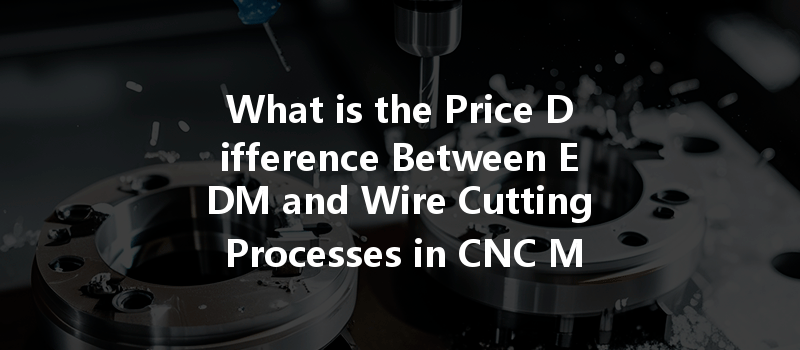Did you know that the global CNC machining market size was valued at approximately $63 billion in 2020 and is expected to grow at an astonishing compound annual growth rate (CAGR) of about 6%? Understanding the various machining processes—such as Electric Discharge Machining (EDM) and Wire Cutting—is crucial for manufacturers aiming to optimize their production efficiency while maintaining cost-effectiveness.
In this article, we’ll explore the price difference between EDM and wire cutting processes, diving into what these technologies entail, their respective costs, and when to use each one. We will also delve into several factors affecting the overall cost, which will help you make an informed decision for your manufacturing needs.
Understanding CNC Machining
CNC machining, or Computer Numerical Control machining, refers to a range of manufacturing processes in which pre-programmed computer software directs the movement of factory tools and machinery. It is essential in producing precision parts and components used in various industries, from automotive to aerospace.
What is Electric Discharge Machining (EDM)?
Electric Discharge Machining (EDM) is a non-traditional machining process that removes material from a workpiece through electrical discharges (sparks). This process is particularly effective for hard materials and is widely used for making intricate shapes and cavities.
Types of EDM:
What is Wire Cutting?
Wire cutting, also a type of EDM, employs a continuously fed thin wire to slice through materials using electrical currents. This method is used extensively to manufacture intricate parts with tight tolerances and high levels of detail.
Pricing Model: EDM vs. Wire Cutting
The pricing structure of both EDM and wire cutting processes is multi-faceted. To understand the price difference, we need to assess several factors involved in both processes.
EDM machines are mechanically advanced and vary in costs based on capabilities and features. Sinker EDM machines often carry a higher price tag than wire EDM machines, primarily due to their complex technology and versatility in producing 3D shapes.
Wire cutting machines, on the other hand, tend to have lower upfront costs. However, the cost of the thin wire used for cutting can add to the overall cost over time.
The materials being machined play a significant role in the cost difference between EDM and wire cutting. EDM is particularly suited for hard metals or conductive materials. The cost of materials being machined can vary significantly. Both processes are generally effective for a wide range of materials, but prices fluctuate based on material properties.
For instance:
Labor costs are considered when evaluating the overall expenditure. EDM processes may require skilled operators to manage the intricate programming necessary for effective operations, especially for programming the sinker EDM.
Wire cutting, in comparison, requires less specialized knowledge, leading to potentially lower labor costs. It is a more straightforward process where less hands-on intervention is usually needed once the machine is set up.
Both EDM and wire cutting processes come with inherent maintenance requirements that can affect lifetime costs.

The time taken to execute machining tasks greatly influences the overall cost. The complex geometries achieved through EDM generally lead to longer cycle times compared to the often quicker wire cutting process.
While wire cutting might appear cheaper in terms of cycle time, it’s important to recognize that the precision and quality offered by EDM can justify its longer machining duration.
Cost Comparison
While it can be difficult to provide exact figures due to the variability in multiple factors impacting overall costs, here is a general comparison that can serve as a guideline:
Such estimates could mean that for manufacturing projects involving high complexity or precision requirements, the investment in EDM may provide better long-term value despite higher initial costs.
When to Use EDM vs. Wire Cutting
Choosing between EDM and wire cutting is not merely a function of price; flexibility in applications must also be a consideration.
When to Choose EDM:
When to Choose Wire Cutting:
Case Studies: Application in Industry
To further illustrate the differences between EDM and wire cutting, let’s look at a few case studies across different sectors:
Case Study 1: Aerospace Industry
In aerospace, complex components with tight tolerances are essential. A manufacturer opted for EDM to produce intricate turbine blades that required specific geometries and material hardness. Despite longer cycle times, the precision and reliability justified the higher costs.
Case Study 2: Consumer Electronics
For a manufacturer producing enclosures for electronic devices, wire cutting was selected due to its efficiency and cost-effectiveness. The relatively simple design allowed for lower cost while maintaining production speed.
Case Study 3: Medical Devices
In the medical industry, both EDM and wire cutting have roles to play. Wire cutting was employed for producing several standard components, while EDM was reserved for more complex devices that required higher precision and customization.
When comparing EDM and wire cutting processes, it is crucial to understand that both methods come with their own advantages and associated costs. Factors such as equipment requirements, labor, materials, and cycle times significantly impact pricing, making it essential to evaluate specific project needs and budgets carefully.
Throughout the article, we’ve explored not just the price difference but also the conditions under which one process may be more effective than the other. By understanding these aspects, manufacturers and design engineers can make informed decisions that will enhance productivity while optimizing costs.
Ultimately, recognizing when to utilize EDM versus wire cutting remains key to maximizing efficiency and ensuring quality production in the ever-evolving landscape of CNC machining. Consider these insights as you plan your next manufacturing project!






